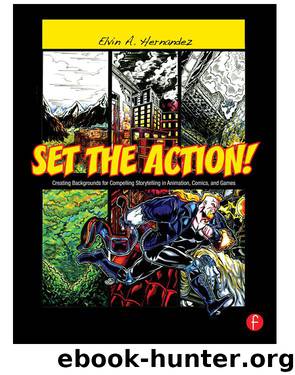Set the Action! Creating Backgrounds for Compelling Storytelling in Animation, Comics, and Games by Elvin A. Hernandez

Author:Elvin A. Hernandez [Elvin A. Hernandez]
Language: eng
Format: epub
Publisher: Routledge
We see a visit to the circus, presented in a way that is fun, enjoyable, and energetic. We get a nice establishing shot of the tent, we see the kids running into the circus (acting like kids tend to act), we get the sense of anticipation and excitement required for a show to start, and we finally see the ringmaster ready to present the act we’ve all been clamoring for. All of this leads us to:
Our strongman character! You may think that the previous page reflects more about the circus than it does to this page’s main star, but you would be thinking only in terms of single images and not in terms of full narrative (oh, you!). The first page is there to create anticipation and to set the audience up for an event in the making, thus implying that our character, the circus strongman, will be bigger and brighter than life! Think of any show or concert you may have gone to—rarely do you see a music act go up on stage on time, but the sense of expectation and excitement, as well as the shared experience of the audience within the arena or park, adds to the tension—and an act that knows a thing or two about showmanship will use this effect to its benefit. By making the audience wait to see the character, we make him bigger, stronger, and more of a sight (of course, you must then deliver on the promise). Movies do this (think of horror or action films in which we don’t see the character but we get a sense of him/her by the places we visit or the tension built before the reveal) as well as games (think of the bigger bosses at the end of levels or the full game itself; the environment tends to announce their presence without actually having the character in view). In fact, just about every form of visual storytelling uses its environments to announce their main characters, and they eventually showcase their strengths and weaknesses in a meaningful way.
With the concept of environments enhancing characters introduced, we can move on to ways in which both character and environment become code-pendent and how the backgrounds themselves are as much a character in the action as the main players. First, though, you must understand how to make these backgrounds stand out in the viewer’s mind and connect with the viewer in a meaningful way, which leads us to iconography.
But, before we go:
Download
This site does not store any files on its server. We only index and link to content provided by other sites. Please contact the content providers to delete copyright contents if any and email us, we'll remove relevant links or contents immediately.
Make Comics Like the Pros by Greg Pak(2422)
Modern Cartooning by Christopher Hart(2186)
Draw-A-Saurus by James Silvani(2105)
Creative Character Design by Bryan Tillman(1557)
Manga Crash Course Fantasy by Mina Petrovic(1554)
Manga Workshop Characters by Sophie Chan(1500)
The Absolutely True Diary of a Part-Time Indian by Sherman Alexie(1499)
How To Draw Caricatures by Lenn Redman(1355)
How to Draw a Character by Soizic Mouton(1333)
Freehand Figure Drawing for Illustrators by David H. Ross(1319)
Learn to Draw Action Heroes by Robert Marzullo(1292)
How to Draw an Object by Soizic Mouton(1281)
The DC Comics Guide to Coloring and Lettering Comics by Mark Chiarello(1270)
The DC Comics Guide to Writing Comics by Dennis O'Neil(1255)
Stan Lee's How to Draw Comics by Stan Lee(1250)
Supergods by Grant Morrison(1241)
ANIME Drawing BOX set 5-in-1: Anime Drawing for Beginners, Drawing Anime Faces, Drawing Anime Emotions, Manga Drawing for Beginners, Anime Drawing Practical Guide by Li Shen & Jane Mackle & Yuka Hiramatsu(1173)
American Political Cartoons by Stephen Hess & Sandy Northrop(1078)
Secret Teachings of a Comic Book Master by Heidi MacDonald(1050)
